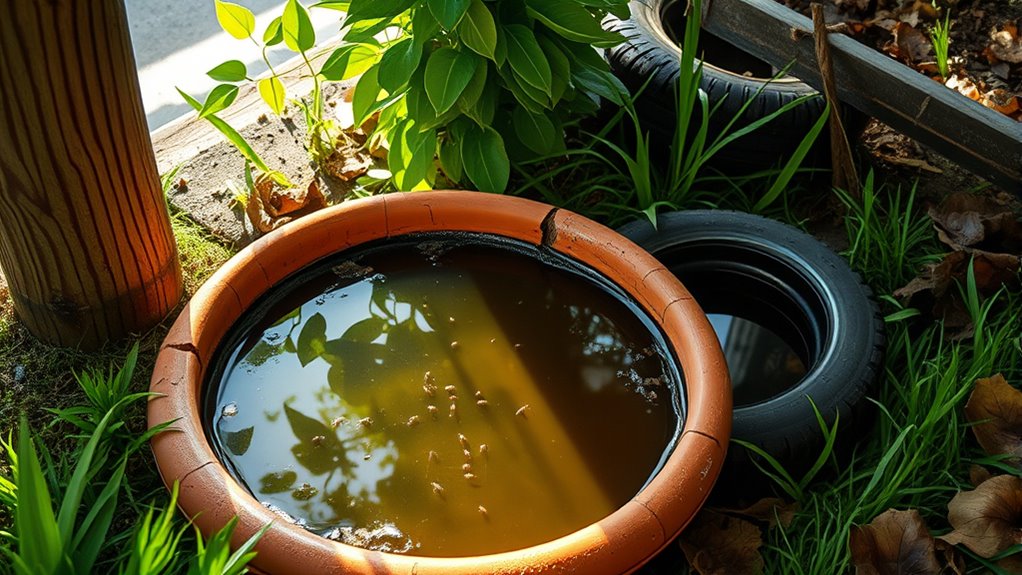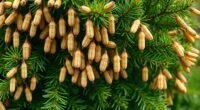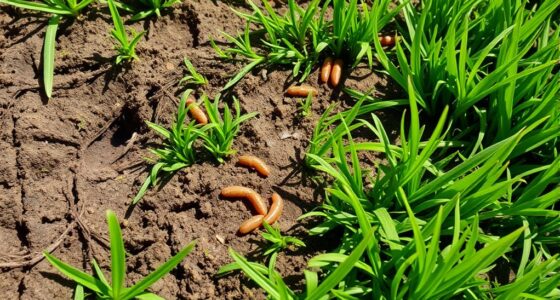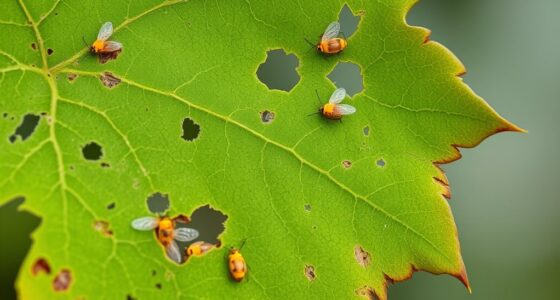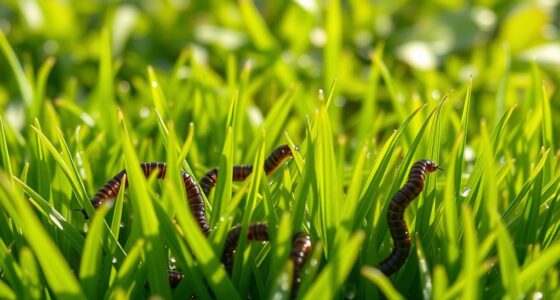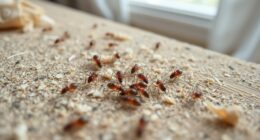Mosquitoes breed mainly in standing water around your home, such as containers, puddles, and clogged gutters. Items like flower pots, buckets, tires, or trash that collect water provide perfect habitats for larvae to develop. Even small puddles or low-lying areas can become hotspots if left untreated. To stop mosquito growth, regularly inspect your yard, empty containers, and remove puddles. Stay with us to discover more ways to keep your home mosquito-free.
Key Takeaways
- Mosquitoes breed in containers holding water, like buckets, flower pots, and discarded cans or bottles.
- Standing water from rain, clogged gutters, or puddles creates ideal breeding sites around homes.
- Small, overlooked water sources such as depressions or low-lying areas often harbor mosquito larvae.
- Regularly empty, cover, or eliminate standing water to prevent mosquito breeding.
- Early identification and removal of breeding sites reduce mosquito populations and disease transmission risks.

Mosquito breeding sites are any standing water sources where mosquitoes lay their eggs and larvae develop. One of the most common types of breeding sites around your home are container habitats. These are any objects or items that collect and hold water, such as flower pots, buckets, tires, birdbaths, or even discarded trash like cans and bottles. These containers often become perfect breeding grounds because they trap water that remains undisturbed for days or weeks, providing an ideal environment for mosquito larvae to thrive. Even small amounts of standing water in these containers can support the development of thousands of mosquitoes over time, so it’s essential to regularly check and empty or clean them. Ensuring that water-holding containers are properly covered or emptied can greatly reduce mosquito breeding opportunities.
Standing water is the primary factor that turns a healthy environment into a mosquito breeding site. This water can accumulate in a variety of places around your property, especially after rain or irrigation. Puddles in the yard, clogged gutters, or depressions in the ground can all hold enough water to support mosquito larvae. What makes standing water particularly dangerous is its persistence; it often stays undisturbed for days, giving mosquito eggs the time they need to hatch and larvae to grow. You might not notice these tiny breeding spots at first, but they can rapidly turn into a significant problem if left unchecked. By removing or draining standing water sources, you cut off the mosquito’s breeding cycle before it gets a chance to intensify.
It’s important to understand that mosquitoes don’t need large bodies of water to reproduce—they thrive in small, overlooked containers and puddles that most homeowners ignore. Regularly inspecting your yard for any items that collect water can drastically reduce mosquito populations. Covering containers or storing them upside down when not in use can prevent rainwater from filling them up. Clearing out clogged gutters ensures water doesn’t pool and create breeding sites. Even a small, seemingly insignificant puddle in a low-lying area can become a hotspot for mosquito larvae if it remains for several days. Your goal is to eliminate or treat any standing water around your home to disrupt the mosquito life cycle. Recognizing breeding sites early can help prevent mosquito infestations and reduce the risk of disease transmission.
Frequently Asked Questions
How Can I Identify Hidden Mosquito Breeding Sites?
To identify hidden mosquito breeding sites, look for standing water in container habitats like old tires, flower pots, or clogged gutters. Check shaded, damp areas around your home, including underneath decks and in dense vegetation. Mosquitoes breed in small amounts of stagnant water, so inspect everything that can hold water. Regularly empty or clean these containers to prevent breeding, and keep your yard dry and well-maintained.
Do Certain Plants Attract Mosquito Larvae?
Imagine lush, overgrown plants where water collects in hidden pockets—these plant attractions create perfect larvae habitats. Certain plants, like bromeliads or any with dense, cup-shaped leaves, trap rainwater, drawing mosquito larvae. You might notice these plants collecting standing water, turning your garden into a mosquito breeding haven. To prevent this, regularly empty or remove such plants, disrupting mosquito life cycles and reducing your risk of bites.
Are There Natural Predators for Mosquito Larvae Around Homes?
Yes, predator species like dragonfly nymphs, certain fish such as gambusia, and some aquatic insects naturally hunt mosquito larvae around your home. These predators help control mosquito populations without significant environmental impacts, making them eco-friendly options for mosquito management. Introducing or encouraging these predator species in nearby water sources can reduce larvae, but verify it doesn’t disrupt local ecosystems or harm native species.
How Often Should I Inspect My Yard for Breeding Sites?
Did you know mosquitoes can breed in just a week? You should inspect your yard weekly, especially after rain, to catch potential breeding sites early. Regular yard maintenance helps prevent stagnant water accumulation, reducing mosquito populations. Staying consistent with inspections keeps you ahead of mosquito breeding, making your outdoor space safer and more enjoyable. Don’t wait too long—weekly checks are your best defense against these pesky pests.
Can Mosquito Breeding Sites Vary by Season?
Yes, mosquito breeding sites can vary by season. During warmer months, seasonal water accumulation like puddles and plant containers become more common, providing ideal breeding spots. Higher temperatures also speed up mosquito development, increasing their numbers. In cooler seasons, breeding sites decrease as water dries up and temperatures drop, slowing mosquito activity. Keep an eye on seasonal water accumulation and temperature effects on breeding to better control mosquito populations around your home.
Conclusion
You should regularly check your surroundings for mosquito breeding sites, like standing water in containers or gutters. Did you know that just one unemptied container can produce up to 300 mosquitoes in a season? By eliminating these sites, you markedly reduce your risk of mosquito-borne diseases. Stay vigilant and take action now—your health depends on it. Small efforts can make a big difference in keeping your home mosquito-free.
